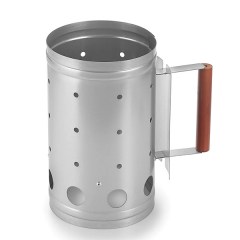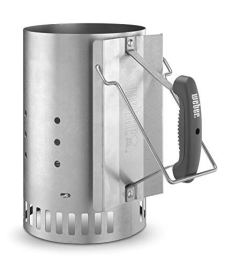
One of the fastest chimney starters available, but you'll pay extra to achieve this speed.
One of the fastest chimney starters available, but you'll pay extra to achieve this speed.
This chimney makes use of a different heat vent than most, ensuring the air is drawn effectively to ignite the charcoal more quickly. Can use the vent to add fuel, such as newspaper, to further speed the process of lighting the charcoal.
More expensive than other charcoal chimneys.

This affordable starter eliminates lighter fluid taste, delivering a pure, smoky BBQ experience.
This affordable starter eliminates lighter fluid taste, delivering a pure, smoky BBQ experience.
The handle keeps cool thanks to its unique wood design. It works well with both types of charcoal. Made from zinc. The built-in heat shield is a nice touch, especially when lighting a large amount of charcoal at a time.
We wish airflow was stronger since it occasionally requires relighting.

A charcoal chimney from a trusted brand that features a shorter shell than typical chimneys.
A charcoal chimney from a trusted brand that features a shorter shell than typical chimneys.
Contains a two-handle design that allows you to control the pouring of lit charcoal more effectively and accurately. Uses a heat shield to protect the handle and keep it safe to touch. Made from aluminized steel.
Takes a while to light all of the charcoal if you overload the chimney.

Smaller design for a charcoal chimney, meaning it will fit small grills nicely.
Smaller design for a charcoal chimney, meaning it will fit small grills nicely.
Inexpensive unit that performs well, especially when used with small grills. Uses a heat shield between the chimney and the handle to keep the handle at a safe temperature. Exceptional air flow.
Metal in the chimney may not stand up to rough treatment, as it bends easily.

The design allows you to release the coals easily through a one-touch valve.
The design allows you to release the coals easily through a one-touch valve.
Vented lower chamber will cause the charcoal to light more quickly than other designs. Also contains an upper chamber, so you can distribute the hot coals more effectively once they're lit.
Barrier between chambers may not hold in place over time, causing problems.

We recommend these products based on an intensive research process that's designed to cut through the noise and find the top products in this space. Guided by experts, we spend hours looking into the factors that matter, to bring you these selections.

There’s nothing like the delicious smoky flavor of burgers, steaks, and veggies prepared on a charcoal grill. Unfortunately, getting the grill ready can be a time-consuming, frustrating process. And if you’ve been trying to light coals without a charcoal chimney, you’re only making it that much harder for yourself.
With a charcoal chimney, you can heat your coals quickly and easily and enjoy your food much sooner. And to get your charcoal going without a hitch, choosing the right chimney is key. With so many options on the market, shopping can be a little overwhelming. You need to settle on the right size, shape, and other features to make sure it performs as well as possible.
If you’re in the market for a charcoal chimney, the handy product list above has our top recommendations. If you’re interested in general tips on what to look for in a charcoal chimney, our shopping guide has plenty of helpful advice.
A charcoal chimney is device used to heat charcoal briquettes or lump charcoal for your grill. It is a cylindrical metal container with a grate inside and perforations around the outside at the bottom. You place the charcoal on the grate and light a fire beneath the coals. The perforations allow air to enter beneath the coals and stoke the fire.
A charcoal chimney is quick and easy to use. The chimney’s design enables the briquettes or lump charcoal to light more quickly and burn more evenly, saving you time and effort.
A charcoal chimney doesn’t require lighter fluid. The main reason that serious grillers use a charcoal chimney is that you don’t have to douse your coals with lighter fluid. Not only can lighter fluid be dangerous if not used properly but it also contains many hazardous chemicals that you probably don’t want in your food. Lighter fluid can also leave behind an unpleasant taste that can affect the smoky flavor of your favorite grilled foods.
How to use a charcoal chimney
Twist and roll a few pieces of newspaper into donut shapes.
Turn the chimney upside down and position the coils of paper in the bottom. Be sure to leave a central hole for airflow.
Turn the chimney right side up and pour charcoal briquettes or lump charcoal onto the grate.
Light the paper. It takes up to 20 minutes for the burning paper to heat the charcoal to the right temperature for grilling.
The coals are ready when ash forms on the exterior of the coals and you see a subtle orange glow between them.
Pour the coals from the chimney into your grill.
Before you buy a charcoal chimney, figure out how much coal your grill holds.
Charcoal chamber
It’s a good idea to choose a charcoal chimney that’s large enough to hold as much charcoal as your grill uses. It means you won’t have to ignite the coal in batches.
Portable grills: If you’re looking for a chimney to use with a portable grill for camping or tailgating, a charcoal chamber that holds five quarts of charcoal should be sufficient.
Full-size grills: For most grills, you’ll want a charcoal chamber that holds at least six or seven quarts of charcoal (about 300 cubic inches or more).
Fuel chamber
It’s also important to consider the size of fuel chamber (the area where you place the newspaper). Too small and the newspaper will be too tightly packed to allow the air to circulate effectively. Choose a chimney with a fuel chamber that has at least 130 cubic inches of space.
It may not seem like an important detail, but the shape of a charcoal chimney is actually key to the successful ignition of the coals.
Cylindrical: Most charcoal chimneys are cylindrical, which effectively allows the air to circulate and makes it easier to pour the hot coals from the container when they’re ready.
You need to be able to transfer the red-hot coals to your grill, so the handle is a very important feature on a charcoal chimney.
Placement: Look at the distance between where you grip the handle and the side of the chimney – the bigger the better.
Heat shield: Some charcoal chimneys also have a heat shield – a thin piece of metal – between the chimney and the handle to further protect your hand from the very hot chimney.
Material: Wooden handles can feel somewhat flimsy, so it’s best to choose a model with a heatproof plastic handle. A molded design can make the chimney more comfortable to hold.
Fire needs oxygen, so proper ventilation is key to effectively lighting the charcoal in your chimney. Choose a model with ventilation holes around the sides of the fuel chamber, as well as down the charcoal chamber.
Charcoal chimneys vary in price based on size and quality of construction. In most cases, you can expect to pay between $10 and $45 for one.
Budget friendly
Small charcoal chimneys that hold less than five quarts of charcoal usually cost from $10 to $15.
Mid-range
Medium charcoal chimneys that hold five to six quarts of charcoal usually cost from $15 to $25.
Expensive
Large charcoal chimneys that hold more than six quarts of charcoal usually cost from $20 to $45.
If you don’t want to use newspaper as fuel for your charcoal chimney, lighter cubes or other premade combustible materials work just as well but cost more.
If it’s raining when you’re preparing your grill, cover the top of the charcoal chimney with a heatproof item to make sure the coals ignite properly.
Slowly pour the charcoal from the chimney into your grill. If you pour too quickly, you could cause a dangerous rush of sparks.
After you add the charcoal to the grill, cover the grill and allow the coals to heat for another ten minutes or so.

Q. Is a charcoal chimney safe to use?
A. If used properly, a charcoal chimney is perfectly safe to use. In fact, using a chimney to ignite your charcoal for grilling is much safer than using lighter fluid or liquid starter, both of which can easily cause flare-ups and leave chemical residue on your food. Remember to never place a charcoal chimney on dry grass, wood, or other flammable surface when igniting the coals – or after you’ve poured the coals into the grill. The metal is still hot!
Q. What are charcoal chimneys made of?
A. All charcoal chimneys are made of metal, most commonly steel, to make sure that they are fully heatproof. Higher-end models are usually made of thick-gauge galvanized steel to increase durability, while mid-range and budget-friendly chimneys are typically made of aluminum- or zinc-coated steel.
Q. How long will my charcoal chimney last?
A. A good charcoal chimney can last up to ten years if properly cared for. That means you shouldn’t leave your charcoal chimney outside and exposed to the elements when it isn’t in use. Store the chimney in a clean, dry spot like the inside of the grill cabinet or on a shelf in your garage or shed.
Get emails you’ll love.
Learn about the products you’re wondering if you should buy and get advice on using your latest purchases.
